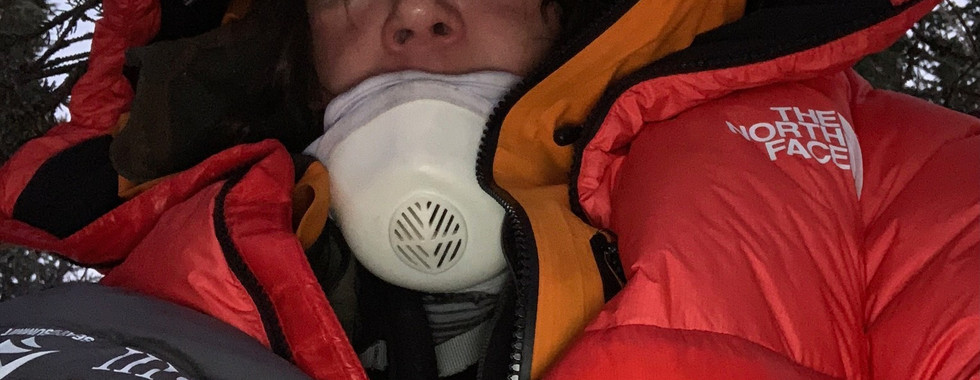I’m about to head back into the depths of the Alaskan winter for my third attempt at the Iditarod Trail Invitational. But before I disappear off the grid, I thought I’d try to answer the question I’ve been asked many times throughout my career: “Why?”
There are lots of good reasons why not to go. I’ve never had much interest in things like climbing Everest (even though I Everested on my bike in the Giddy Up Challenge last year!), and I once swore that I would never do a winter bike expedition. While I’m good at suffering through a lot of things, my body's just not good in the cold, and racing through sub-zero temperatures is more than daunting. Besides, I already won the women’s division of the ITI’s 350-mile bike race in 2019.
But I built the early part of my career on competing in expedition-style adventure races before becoming a more-or-less full-time cyclist. One of the many things I learned from my 2015 experience of riding the 1,200-mile Ho Chi Minh Trail was how much I was missing expeditions. Before my first ITI, I felt that I hadn't really challenged myself in a number of years. I had done a bunch of hard stuff, but nothing that was truly committing. And there’s nothing more committing than the Alaskan wilderness, in winter, alone.
Year one, the dominating feeling and emotion was fear. I felt out of my depth and I spent so much emotional energy being afraid. Yes, I finished and won the women’s division, but more than anything I learned how much I still needed to learn.
Photos from ITI 2019
Year two, I was focused. I wrote down all the things that went wrong the year before and what I needed to do differently. I trained more, dialed in my equipment better, and changed my nutrition strategy. When the weather turned horrific, I adapted, used my new skills and teamed up with my husband, Greg, who was also out there racing. Because the conditions were so gnarly, we were out on the trail for over seven days in 2020. I credit my survival in those conditions on my focus and preparation. Even in minus 40-degree conditions and record snow levels, I proved to myself that I could survive out there.
Photos from ITI 2020
This year, while I’m still a little fearful and definitely focused, I’m actually feeling festive. After everything that has happened over the last 12 months, and with the wealth of knowledge I’ve gained in the last few years about winter bike expeditions, I am really excited to go back again. I want to see my friends out there. I want to see the trail. I want to howl with the wolves. I am excited to harness the experience and confidence that has been building these three years and execute a solid, solo expedition.
The last time I travelled was coming home from Iditarod 2020 a year ago. Given the state of the pandemic, I did not make my decision to go back lightly. I have been training as if I would go, but didn’t decide for sure until a few weeks ago. I wanted to know we could safely compete in the midst of this pandemic and be sure that I was comfortable with the protocol and safety measures.
But when the ITI race organizers released details of everything they were going to do to make the event safe for competitors and responsible for everyone else, I realized that, yes, I could do this without putting anyone at unnecessary risk. (As firefighters, Greg and I are also fortunate that we have already been vaccinated.) They canceled the 1,000-mile race—I'm kind of grateful to get another excuse to practice on the “short” course—and turned the 350-mile route into an out-and-back to avoid going through any of the isolated native villages. They made masks a mandatory piece of equipment. They’re requiring multiple negative tests for racers and volunteers, including a start line and finish line rapid test. Anyone who tests positive will not be involved with the event. The course has been modified to avoid going through any remote villages and access to any indoor refuge is limited. They are truly creating an Iditarod Trail Invitational bubble and I am grateful for this assurance that the 50 racers and volunteers can compete safely.

Updated Course for 2021
And I'm also planning to try to be almost entirely self-sufficient. While the checkpoint cabins are few and far between, I don’t plan on using any of them for shelter as I have in the past. My goal is to truly push my experience and confidence in this frozen environment to the next level. This includes melting snow for hydration, sleeping outside and relying only on the food I carry and drop bags that were sent ahead of time for nutrition.
So back to the “why”. Yes, I’m going to truly challenge myself, but I am also going to truly understand myself. Moving under my own power in remote, isolated terrain is where I learn and explore who I am. The trail is my teacher and committing, physical effort is the vehicle that I use for exploration inside and out. So I’m headed out into the cold wilderness for a few days to spend time with the wolves, the moose and myself. I will be out of touch, but still want to bring you along for the ride. I’ll be taking video and photos along the route, and you can also track my progress here. And check out some of the riding from year 1 and year 2.
The ITI has shown me that I'm far more capable than I gave myself credit for in these kinds of extreme environments. I would have never believed I could survive in the depths of the Arctic winter on my own without this challenge. I’m sure there are things you don’t think you can do. I want to inspire you to believe that you can.
So wish me luck, #BeGood, and #JoinTheRusch. And I’ll be back to let you know how it all went soon.













































Comments